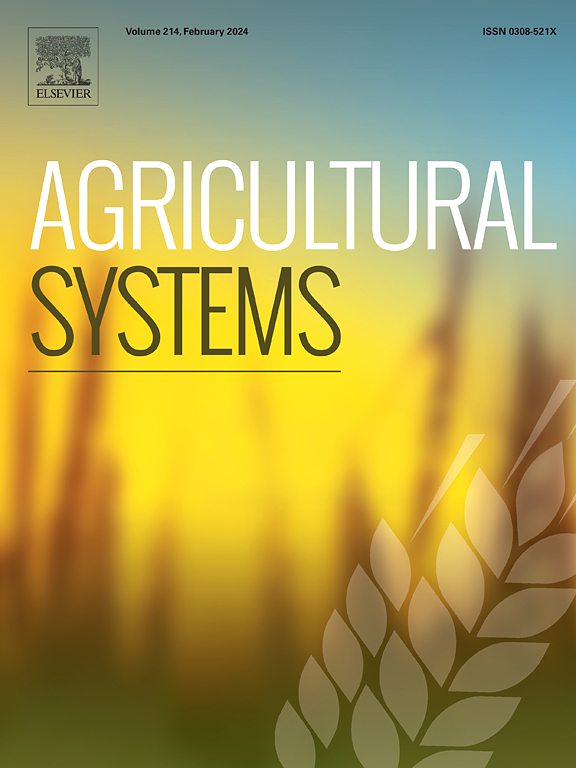Analysis of mathematical modelling approaches to capture human behaviour dynamics in agricultural pest and disease systems
IF 6.1
1区 农林科学
Q1 AGRICULTURE, MULTIDISCIPLINARY
引用次数: 0
Abstract
CONTEXT
The integration of dynamic human behaviour into epidemiological models aims to improve the effectiveness of pest and disease management in crops and livestock, crucial for sustainable food and agriculture systems, especially amid current challenges such as climate change, globalisation and chemical use.
OBJECTIVE
This structured scoping review focuses on how dynamic human behaviour is integrated into mathematical models for pest and disease control, using mathematical frameworks such as game theory and agent-based modelling, providing a comprehensive analysis of literature from the last decade.
METHODS
To identify and assess relevant studies, an extensive and systematic search for literature was conducted using the Web of Science database, followed by a manual screening process.
RESULTS AND CONCLUSIONS
Most studies focused on stochastic and spatially explicit types of models that capture the complexity of agricultural pest and disease systems. Various control strategies, including chemical control, cultural methods, and integrated pest management, are identified, highlighting the presence of context-specific approaches in epidemiological models, considering diversity of agricultural systems and heterogeneity in farmer behaviour. The review also identifies gaps in current research, such as the limited focus on dyadic behaviours (e.g. farmer-to-advisor interactions), limited interdisciplinary collaboration, and reliance on secondary data sources. By addressing these gaps, a more comprehensive and practical understanding of the dynamics within agricultural systems, particularly in relation to human behaviour can be achieved.
SIGNIFICANCE
Modellers are encouraged to foster interdisciplinary work with social scientists and collection of primary social data to better capture human behaviour for modelling agricultural pest and disease systems.

分析数学建模方法,以捕捉农业病虫害系统中的人类行为动态
将动态人类行为纳入流行病学模型的目的是提高作物和牲畜病虫害管理的有效性,这对可持续粮食和农业系统至关重要,特别是在气候变化、全球化和化学品使用等当前挑战的背景下。这篇结构化的范围审查侧重于如何利用博弈论和基于主体的建模等数学框架将动态人类行为整合到病虫害控制的数学模型中,并对过去十年的文献进行全面分析。方法为了识别和评估相关研究,使用Web of Science数据库进行广泛而系统的文献检索,然后进行人工筛选过程。结果与结论大多数研究都集中在随机和空间明确的模型类型上,这些模型反映了农业病虫害系统的复杂性。确定了各种控制策略,包括化学控制、培养方法和病虫害综合管理,强调流行病学模型中存在针对具体情况的方法,考虑到农业系统的多样性和农民行为的异质性。该综述还指出了当前研究中的差距,例如对二元行为(例如农民与顾问的互动)的关注有限、跨学科合作有限以及对二手数据源的依赖。通过解决这些差距,可以实现对农业系统内部动态,特别是与人类行为有关的动态的更全面和实际的理解。鼓励建模人员促进与社会科学家的跨学科合作,并收集主要社会数据,以便更好地捕捉人类行为,为农业病虫害系统建模。
本文章由计算机程序翻译,如有差异,请以英文原文为准。
求助全文
约1分钟内获得全文
求助全文
来源期刊

Agricultural Systems
农林科学-农业综合
CiteScore
13.30
自引率
7.60%
发文量
174
审稿时长
30 days
期刊介绍:
Agricultural Systems is an international journal that deals with interactions - among the components of agricultural systems, among hierarchical levels of agricultural systems, between agricultural and other land use systems, and between agricultural systems and their natural, social and economic environments.
The scope includes the development and application of systems analysis methodologies in the following areas:
Systems approaches in the sustainable intensification of agriculture; pathways for sustainable intensification; crop-livestock integration; farm-level resource allocation; quantification of benefits and trade-offs at farm to landscape levels; integrative, participatory and dynamic modelling approaches for qualitative and quantitative assessments of agricultural systems and decision making;
The interactions between agricultural and non-agricultural landscapes; the multiple services of agricultural systems; food security and the environment;
Global change and adaptation science; transformational adaptations as driven by changes in climate, policy, values and attitudes influencing the design of farming systems;
Development and application of farming systems design tools and methods for impact, scenario and case study analysis; managing the complexities of dynamic agricultural systems; innovation systems and multi stakeholder arrangements that support or promote change and (or) inform policy decisions.
 求助内容:
求助内容: 应助结果提醒方式:
应助结果提醒方式:


